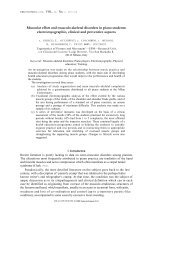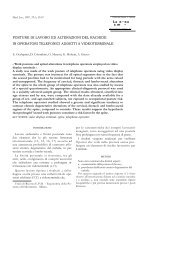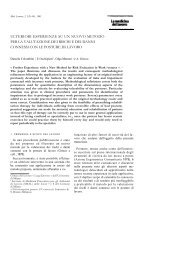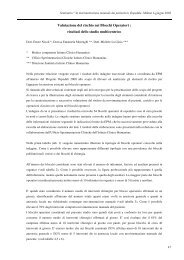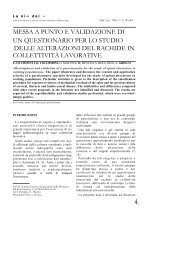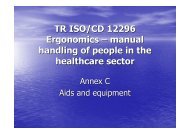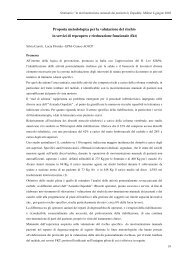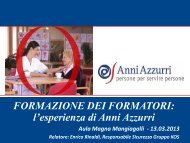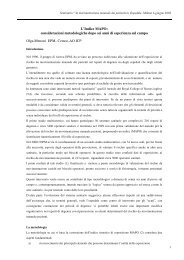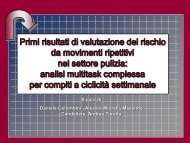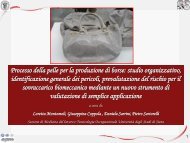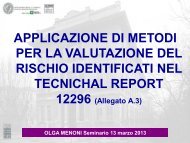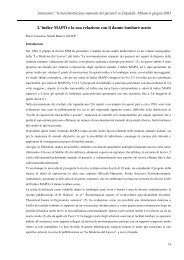Ocra method a new procedure for analysing multiple repetitive tasks
Ocra method: a new procedure for analysing multiple ... - epm
Ocra method: a new procedure for analysing multiple ... - epm
Create successful ePaper yourself
Turn your PDF publications into a flip-book with our unique Google optimized e-Paper software.
CONCLUSIONSIn some productive areas (agriculture, construction,cleaning, food, etc.) the need is emerging to face upper limbbiomechanical overload. Exposure assessment is much morecomplex being characterised by the presence of severalworking <strong>tasks</strong> over periods longer than the current workingday (weekly, monthly, yearly turnover).The present workreports organizational study <strong>procedure</strong>s as well as exposuremodels (starting from OCRA checklist intrinsic values pereach identified task) to get to assess the final exposure valuevia 3 calculation model assumptions..The future work allowing selection of the most reliablemodel (because more predictive), will necessarily go throughthe collection of epidemiological data. Now collection pointsof this in<strong>for</strong>mation are active in Italy (Siena University), inSpain and Chile (UPC Barcelona). The first national data onvineyard pruning and olive harvest in the Siena area (approx90 workers) and other fruit harvesting in the Romagna area(approx 50 workers) seem to confirm once again betterprevision <strong>for</strong> OCRA Multitask Complex model.Un<strong>for</strong>tunately clinical data collection in agriculture as insuperstores or the cleaning sector is extremely complex andhence collection of sufficient epidemiological data might ask<strong>for</strong> rather long times.In the meanwhile, to help colleagues in collectingorganizational and exposure data, easily usable software areavailable and able to provide, once final organizational datahave been input as well as different task intrinsic indices, theautomatic computing of exposure levels to these extremelycomplex work organizational models under the differentassumptions of definite mathematical models.REFERENCESHagberg M, Silverstein B, Wells R, Smith MS, HendrichHW, Carayon P, Perusse M, 1995. Work-relatedmusculoskeletal disorders: a reference book <strong>for</strong> prevention.Taylor and Francis, London.Colombini D, Occhipinti E, Grieco A, 2002. Risk assessmentand management of <strong>repetitive</strong> movements and exertions ofupper limbs, Elsevier Science, Amsterdam.Colombini D, Occhipinti E, 2008. The OCRA Method (OCRAIndex and Checklist). Updates with special focus on multitaskanalysis. Conference Proceedings. AHFE 2008 Las Vegas –July 2008. Eds W. Karkwoski and G. Salvendy. ISBN 978-1-60643-712-4.Occhipinti, E, 1998. OCRA, a concise index <strong>for</strong> theassessment of exposure to <strong>repetitive</strong> movements of the upperlimbs. Ergonomics 41, 9, 1290-1311.Occhipinti E, Colombini D ,2007. Updating reference valuesand predictive models of the OCRA <strong>method</strong> in the riskassessment of work related musculoskeletal disorders of theupper limbs (UL-WMSDs). Ergonomics, 50, 11, 1727–1739.Occhipinti E , Colombini D, Occhipinti M, 2008. Metodo<strong>Ocra</strong> : messa a punto di una nuova procedura per l’analisi dicompiti multipli con rotazioni infrequenti. MEDLAV (LaMedicina del Lavoro), 99, 3, 234-241.10



